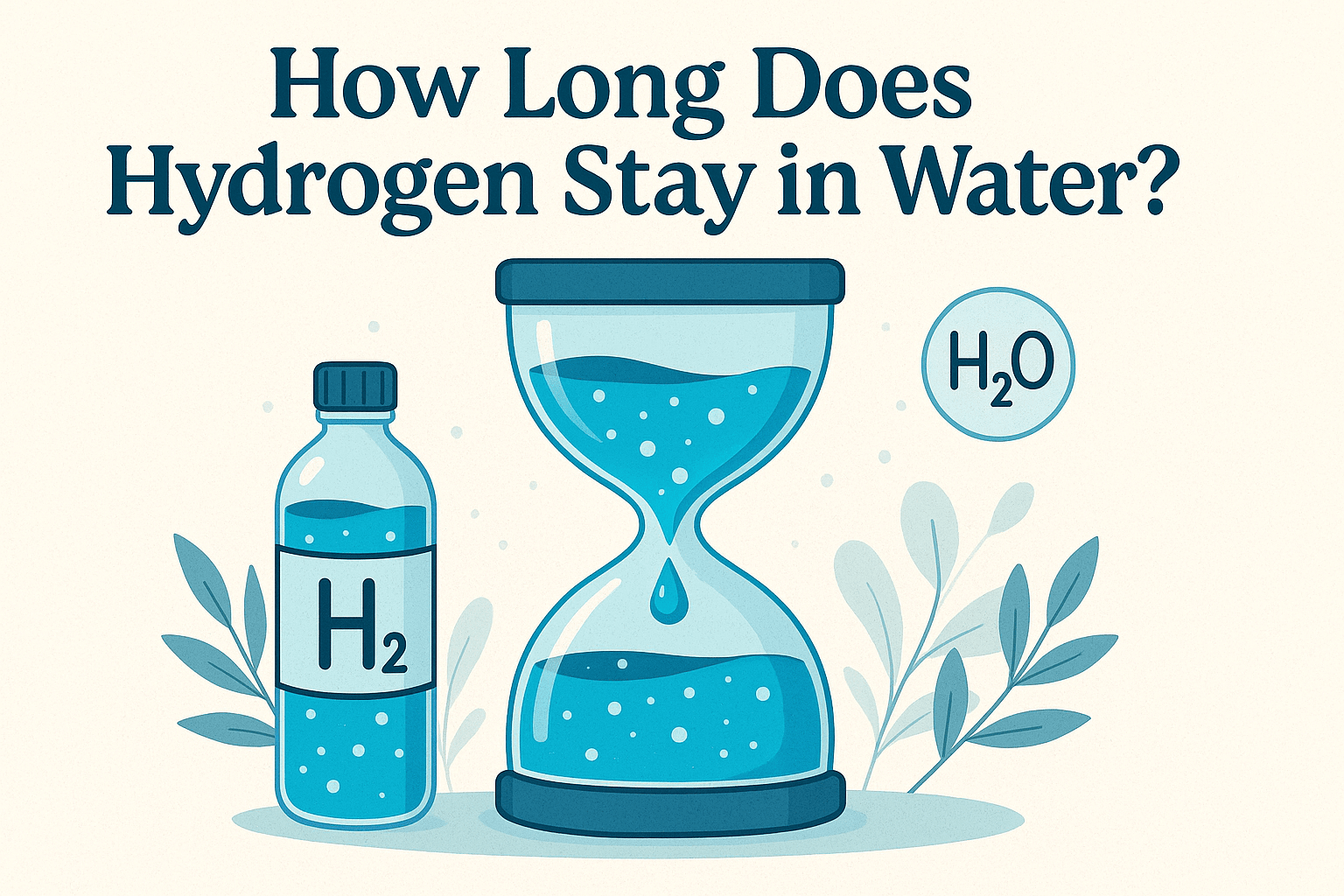
How Long Does Hydrogen Stay in Water?
Why freshness, temperature, container choice, and air exposure matter for real-world H₂ benefits.

Hydrogen water has surged in popularity—and a key question keeps coming up: how long does the hydrogen actually stay in the water? Understanding shelf life helps you time production and storage for maximum benefit.
New to H₂? Start with our Hydrogen Water: The Ultimate Guide (2025).
Key Takeaways
- Hydrogen can remain from ~20 minutes to 48 hours depending on storage.
- Cold, sealed containers retain H₂ much longer than warm, open ones.
- Drink fresh when possible; proper storage makes a big difference.
How Long Does Hydrogen Stay in Water?
Hydrogen gas typically stays in water for ~20 minutes to 48 hours, with storage conditions being the deciding factor. Once exposed to air, H₂ begins escaping quickly; sealed, chilled bottles slow this loss substantially.
Several variables drive retention: temperature, container material, seal quality, headspace, and agitation.
Hydrogen Dissipation Rates
In open containers, hydrogen concentration often drops to near-zero within 2–3 hours under normal conditions.
- First 30 minutes: ~50–70% loss
- 1–2 hours: ~80–90% loss
- 3+ hours: nearly complete loss
Tip: Pour only what you’ll drink now; keep the rest sealed.
Sealed containers retain hydrogen far longer—especially when refrigerated. Tight-seal glass or specialty bottles can maintain levels for days when handled carefully.
Portable, on-demand: Echo Go · Premium flask: Echo Flask
Temperature matters: warmer water accelerates H₂ escape; cooler temperatures slow it down.
Factors Affecting Hydrogen Retention
Container Material
- Glass: generally best retention
- Plastic: faster H₂ loss through permeation
- Metal: moderate, depends on design/seal
Storage Conditions
- Cold slows escape; heat speeds it up
- Sunlight & warmth increase loss rates
- Less headspace = slower off-gassing
Water Movement & Pressure
Agitation (shaking, stirring) accelerates loss by increasing air contact. Lower atmospheric pressure (high altitude) can also speed escape.
Hydrogen Escape Mechanisms
- Surface evaporation: H₂ at the surface breaks free into air.
- Diffusion: H₂ moves from higher to lower concentration until equilibrated.
- Bubble formation: microbubbles rise and burst, releasing H₂ rapidly.
Hydrogen’s extremely small molecular size makes it especially prone to escape—even through some packaging materials that block larger gases.
Maximizing Hydrogen Retention in Water
Smart storage and timing can extend active H₂ life from mere hours to multiple days.
Impact of Storage Methods
- Refrigerate (≈35–40°F / 2–4°C) to slow off-gassing.
- Seal tightly and avoid repeated opening/closing.
- Minimize agitation during transport.
A tightly sealed bottle can maintain levels for 1–3 days when refrigerated.
Air exposure is the biggest threat—H₂ starts escaping immediately on contact with air. Keep unopened bottles chilled until use.
Storage guide: How to Store Hydrogen Water
Role of Containers and Materials
- Glass: excellent barrier; great for fridge storage.
- Aluminum bottles/pouches: good retention with quality seals.
- Standard plastic: higher permeability → faster loss.
Explore generators & bottles: Hydrogen Machines · Echo Go · Echo Flask
Smaller, full containers leave less headspace, slowing H₂ escape. Avoid freezing (can damage seals and affect retention).
Practical Tips for Consumption
- Drink within ~2 hours of opening for peak levels.
- Pour only what you’ll drink now; keep the rest sealed.
- Consume straight from the original container when possible.
Check product labels for device- or brand-specific storage guidance. Fresh generation typically yields the highest ppm.
Shop H₂ systems: Hydrogen Water Collection
Frequently Asked Questions


